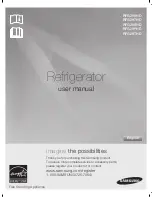
9
3. Unscrew the shaft
2
from the lower bracket
7
. Screw it together with all the washers into the
bracket
7
on the other (opposite) side, symmetrically to the former position (see figure).
Slide the door onto the
7
axles of the bracket.
4. Rotate the bracket
6
with the washers on the shaft and the plastic gasket at an angle of
1800, unscrew the shaft together with the washers and screw in on the opposite side of the
bracket. After inserting the bracket
6
, screw it into the refrigerator compartment door on
the opposite side of the refrigerator in the upper holes.
5. Cover the bracket and the remaining empty cavity with lids
c
.
6. Remove the screw caps a and the blinds
b
. Unscrew the screws securing the handles. Move
the handles in the opposite direction and tighten. Press the blinds into the remaining holes
in the door and place the covers on the screws.
7. Remove the cover
10
from the lower cover
1
and insert it into the guides on the other side
of the lower cover (symmetrical to the previous position). Insert the left and right legs of the
lower cover
1
into the holes (see figure) and slide until the cover locks in place.
OPERATION PROBLEMS AND THEIR SOLUTIONS
•
The appliance is plugged in to the mains but it does not work.
Check that your house
electricity supply installations are in order. Check that the plug is correctly inserted into the
electricity supply socket.
•
The noise has become louder.
Check that the appliance is standing stable, on a level place.
To make it level, regulate the front feet. Check if the appliance is not touching any furniture,
and that no part of the refrigeration system at the back part of the appliance body is touching
the wall. Pull the appliance away from any furniture or walls. Check that the cause of
increased noise isn’t due to bottles, cans or dishes in the appliance that might be touching
each other.
•
Water has appeared at the bottom of the refrigerator compartment.
Check whether
a thaw water channel space isn’t blocked. Clean the thaw water channel space with a cleaner
intended for that purpose.
•
Water has appeared under the appliance.
The thaw water collection tray has slipped off
the compressor. Place the tray on top of the compressor.
•
When the appliance door is opened, the rubber sealing gasket pulls out.
The gasket
is smeared with sticky foodstuffs (fat, syrup). Clean the sealing gasket and the groove for it
with warm water containing soap or dishwashing detergent and wipe dry. Put the rubber
sealing gasket back into the place
•
High temperature in appliance, the compressor operation pauses are short.
Ascertain whether the appliance doors are shutting tightly, whether the door wasn’t kept open
longer than necessary when taking out or putting in foodstuffs or whether a large amount of
warm food was placed in the appliance.
•
The top of the appliance has condensation on it.
The ambient relative air humidity is
above 70 %. Ventilate the room where the appliance stands and if possible remove the cause
of the humidity.
Remarks on the appliance operating noise.
As the appliance operates and goes through
the freezing cycle, various noises will be emitted. This is normal and is not a sign of any
malfunction.
As the refrigerant circulates around the refrigeration system, it causes sounds like
murmuring, bubbling, or rustling. Louder sounds like popping or clicking may be heard for a
short time as the refrigerator’s compressor switches on.











































